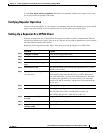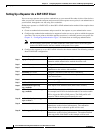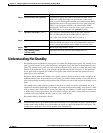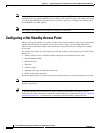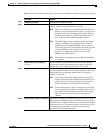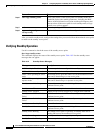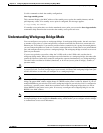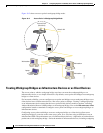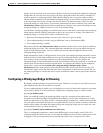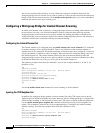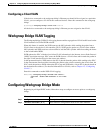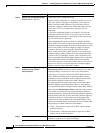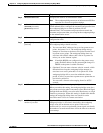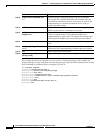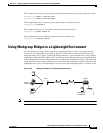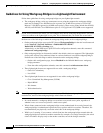
19-15
Cisco IOS Software Configuration Guide for Cisco Aironet Access Points
OL-30644-01
Chapter 19 Configuring Repeater and Standby Access Points and Workgroup Bridge Mode
Understanding Workgroup Bridge Mode
bridges, that can associate to an access point or bridge. To increase beyond 20 the number of workgroup
bridges that can associate to the access point, the access point must reduce the delivery reliability of
multicast packets to workgroup bridges. With reduced reliability, the access point cannot confirm
whether multicast packets reach the intended workgroup bridge, so wired clients of workgroup bridges
at the edge of the access point coverage area may not receive all multicast frames. When you treat
workgroup bridges as client devices, you increase performance but reduce reliability. You use the no
infrastructure client configuration interface command to configure access points and bridges to treat
workgroup bridges as simple client devices. This is the default setting.
You should use a workgroup bridge as an infrastructure device if the devices connected to the workgroup
bridge require network reliability equivalent to that of an access point or a bridge. You should use a
workgroup bridge as a client device if these conditions are true:
• More than 20 workgroup bridges associate to the same access point or bridge
• The workgroup bridge associates using an SSID that is not an infrastructure SSID
• The workgroup bridge is mobile
Please notice that the (no) infrastructure client command is entered on the access point to which the
workgroup bridge associates. This command determines whether the access point should add unicast
copies of each multicast frames, sent in a reliable (unicast with acknowledgment) fashion to each
workgroup bridge in the cell.
When infrastructure client is configured on the access point, each workgroup bridge potentially receives
both the multicast initial frame and the unicast copy. Processing both frames (carrying the same upper
layer content) creates processing inefficiency on the workgroup bridge. You can configure the
workgroup bridge to consider the multicast frame and discard the unicast copy (default), or consider the
unicast frame and discard the multicast original frame. To configure this behavior on the workgroup
bridge radio, use the command station-role workgroup-bridge multicast mode {client |
infrastructure}. The client option considers the multicast frame and discards the unicast copy. The
infrastructure option echoes the Infrastructure Client configuration on the main access point, and sets
the workgroup bridge to consider the unicast copies of multicast frames, and not process the multicast
frames.
Configuring a Workgroup Bridge for Roaming
By default, workgroup bridges are expected to be static. Therefore, once they are associated to an access
point SSID, they do not scan for other access points.
If your workgroup bridge is mobile, you can configure it to scan for a better radio connection to a parent
access point or bridge. Use this command to configure the workgroup bridge as a mobile station:
ap(config)# mobile station
When you enable this setting, the workgroup bridge scans for a new parent association when it
encounters a poor Received Signal Strength Indicator (RSSI), excessive radio interference, or a high
frame-loss percentage. Using these criteria, a workgroup bridge configured as a mobile station searches
for a new parent association and roams to a new parent before it loses its current association. When the
mobile station setting is disabled (the default setting) the workgroup bridge does not search for a new
association until it loses its current association.
ap(config-if)#mobile station minimum-rate <data rate>
This is a configurable parameter to control when WGB triggers a new roaming event. If this cli is
configured and if the current data rate is lower than the configured value, the new roaming process will
be triggered. This will reduce unnecessary roaming and allows to have an expected rate value.



